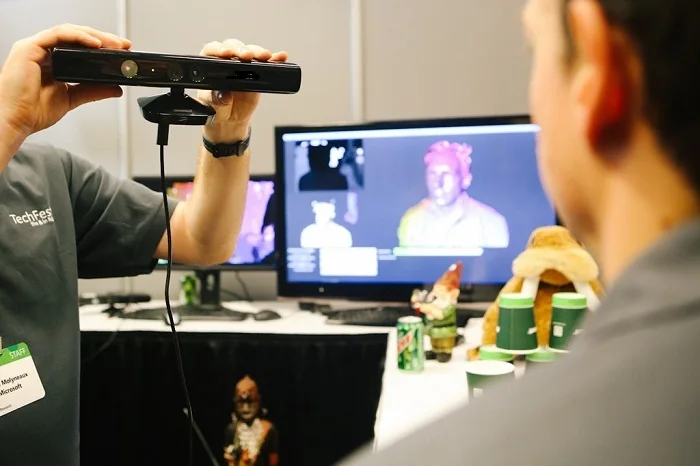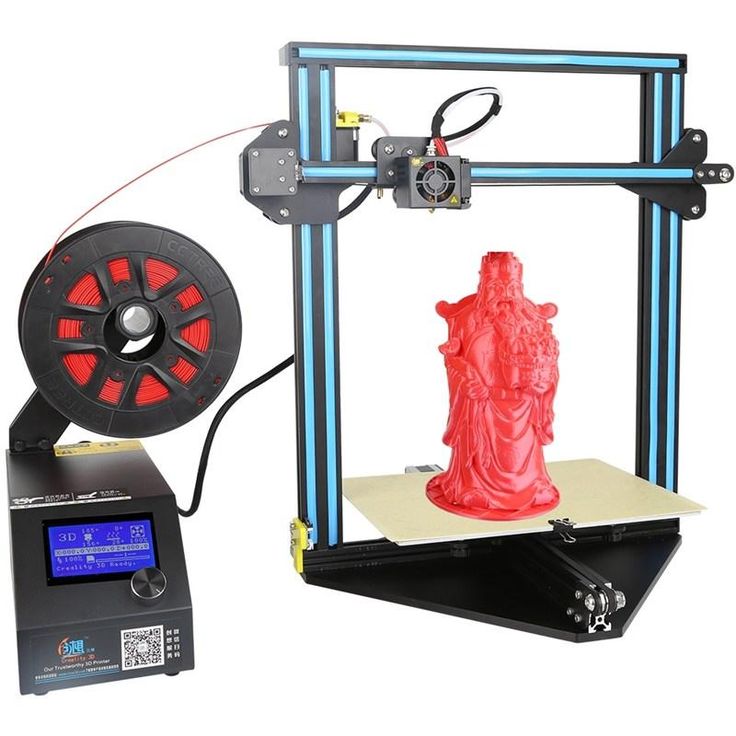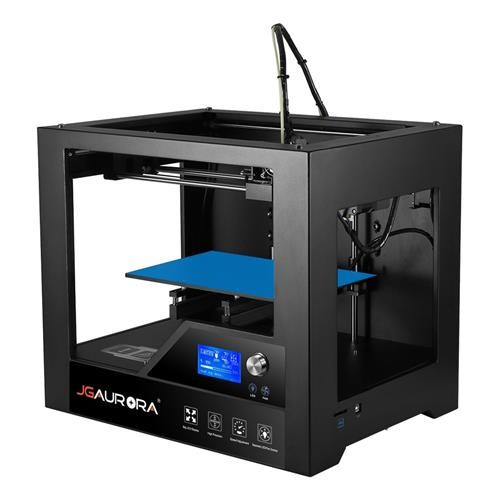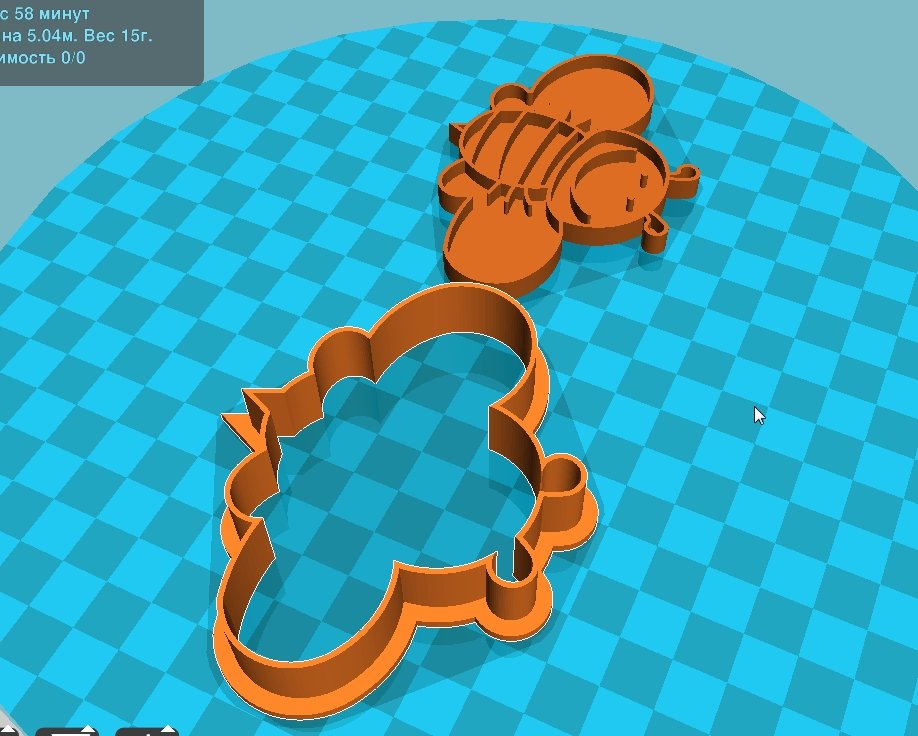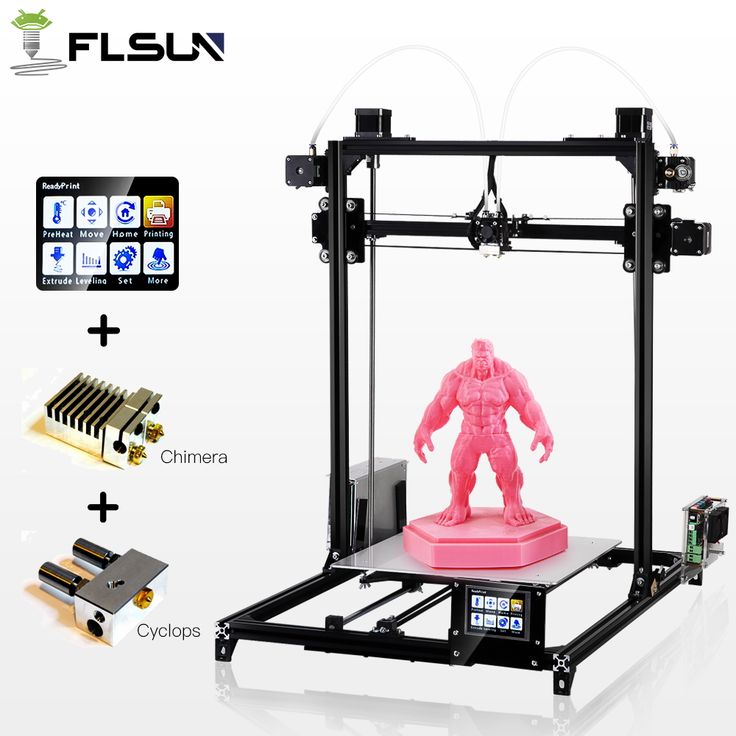Fused filament fabrication 3d printer
Fused filament fabrication technology for 3D printing
David Roberson7 January 2021
Trends
FFF 3D printing, or fused filament fabrication, is an additive manufacturing (AM) process in which thermoplastic material is pushed through a heated nozzle to create objects layer by layer.
What Is FFF 3D Printing?
While it has its origins as a proprietary manufacturing technology from the 1980s, desktop FFF really took off just over 10 years ago when patents expired and projects like the open-source RepRap initiative led to greater innovation and affordability.
Today, FFF technology is typically a lower-cost solution compared to other 3D printing processes, both in terms of initial investment and running costs. It’s also renowned for being easy to understand and use – making it ideal for busy engineers and elementary school kids alike.
But it has proven so reliable, accurate, and capable of producing robust parts over the years that most of the world’s leading manufacturing, design, and education organizations now use it to drive innovation.
The FFF 3D printing process
FFF 3D printing uses
Let’s look more closely at the applications of FFF 3D printing:
Manufacturing. With faster lead times than outsourcing and a wide range of engineering materials, FFF 3D printing is used widely in manufacturing industries. 3D printers deliver rapid tooling and replacement parts to maintain maximum uptime and productivity on the production line. And they are used to flexibly create end-use parts, such as bespoke quality gauges or small batch first runs, to speed up time to market of a product
Prototyping. Low-cost materials and short print times make FFF 3D printing ideal for the iterative design process. 3D printed prototypes can be used to visualise concepts or functionally test technical parts
Education. Affordable and easy-to-use FFF hardware enables a variety of education applications – from engaging younger students with STEAM basics to providing production labs for college and university students to work on engineering projects and develop skills for the modern workplace
Ford saved roughly $1,000 per tool by developing 3D printed manufacturing aids using Ultimaker printers
Learn more about the range of 3D printing applications and how experienced AM engineers identify them in this episode of the Talking Additive podcast.
FFF materials
Plastic polymers are the most used materials for FFF technology, of which there are many for countless uses.
Composites that combine a polymer with fibers of carbon, metal, glass, or other materials are also widely used for various structural benefits, although these cannot be printed reliably on all FFF 3D printers. Technically it is also possible to print food and biological pastes using 3D printing technology, although this is typically reserved for experimental or research applications.
Another important category of material for FFF printers is known as “support” material. This is needed when the orientation or shape of a part makes it impossible to print from bottom to top – for example, a part with a large overhang. Support materials are designed to be easy to remove.
Material for FFF 3D printers is typically sold as spools of filament, each containing from 250 g to 1 kg of material.
Some 3D printers can print parts with multiple materials or colors
Loading filament on an Ultimaker S5 Pro Bundle printer
If you’re thinking of buying a 3D printer, always check the compatible materials.
For some, you may be limited to using two or three materials. Other printers may claim to work with any material, but soon develop technical issues from wearing caused by printing abrasive composite materials. And some FFF 3D printers are limited to using the manufacturer’s proprietary materials only, while others offer an open filament system (like Ultimaker) compatible with third-party products.
Some of the most common FFF 3D printing polymers are PLA (polylactic acid), which is often used as a “beginners” material due to its ease of use, and ABS (acrylonitrile butadiene styrene), which offers some superior mechanical properties and heat resistance.
But with thousands of filaments on the market, it’s worth diving a little deeper into their properties to get an understanding of how many applications are possible with a high-quality FFF 3D printer.
| Material | Properties |
|---|---|
| PLA (polylactic acid) | Excellent surface quality and detail. Mechanical and heat properties not suitable for some applications Mechanical and heat properties not suitable for some applications |
| ABS (acrylonitrile butadiene styrene) | Strong, ductile material with wear resistance and heat tolerance |
| Nylon (polyamide) | Strong yet flexible, with good chemical, impact, and abrasion resistance |
| PETG (polyethylene terephthalate glycol-modified) | Good toughness and wear resistance, with chemical resistance against many industrial fluids. |
| CPE (copolyester) | Durable and flexible with a glossy finish and good impact and heat resistance |
| PC (polycarbonate) | Strong and tough material with heat resistance up to 110 °C |
| TPU (thermoplastic polyurethane) | Flexible material with rubber-like properties. Provides high impact and wear resistance |
| PP (polypropylene) | Durable, tough, and fatigue resistant. Retains shape after torsion, bending, or flexing |
| PVA (polyvinyl alcohol) | Water-soluble material used to create supports for overhangs and cavities |
The table above covers the main polymers you can print on a professional 3D printer.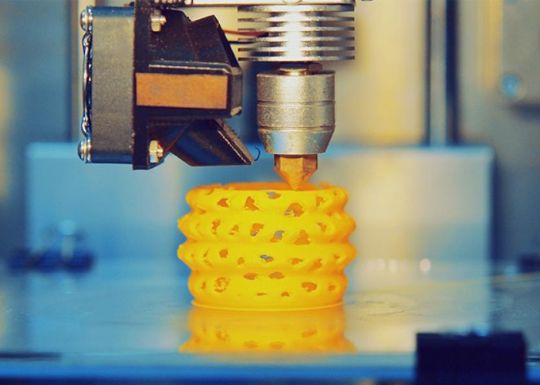 Want to find the right composite material for your 3D printing applications? Watch our webinar on composites for 3D printing.
Want to find the right composite material for your 3D printing applications? Watch our webinar on composites for 3D printing.
FFF 3D printers
Although FFF 3D printers are all built on the same process, their capabilities differ a lot.
One of the biggest differences can be in material compatibility (see the section above), with the hardware being especially important in defining what sort of composites can be printed.
Size is another key differentiator of FFF 3D printers. The printable space (which limits the size of a single print or batch) is called the build volume or build envelope. This can vary considerably – from 10 cm (3.9 inches) of printable space in the X, Y, and Z dimensions, up to around 1 meter (39 inches) in one or more of these dimensions in the largest units. Note that a stiff, stable build platform aids the FFF process – so large format printers generally mean a trade-off in quality.
An example of the different sizes and configurations possible with FFF 3D printers
The different features of a FFF printer are too many to highlight in an introduction, so here are definitions of a few of the most important:
Build plate or platform.
 The surface onto which the material is extruded and then cools to form the printed part. It is typically made of glass or metal. A professional standard 3D printer should offer a heated build plate, which enables use of more materials
The surface onto which the material is extruded and then cools to form the printed part. It is typically made of glass or metal. A professional standard 3D printer should offer a heated build plate, which enables use of more materials Nozzle. The nozzle extrudes the molten material. It is housed in the print head and positioned via a gantry operated by stepper motors. The number of nozzles a printer has will determine how many materials can be combined in one print – typically one or two (known as single or double extrusion)
Feeder. The mechanism that feeds filament from the spool to the printer
Display. The interface through which the printer is controlled
Connectivity. Many 3D printers offer local network or cloud connectivity for remote operation
Environment control. While some FFF 3D printers are little more than open platforms, enclosing the build chamber and adding environment control (such as the Ultimaker S5 Pro Bundle) offer both print quality and safety benefits
Material handling.
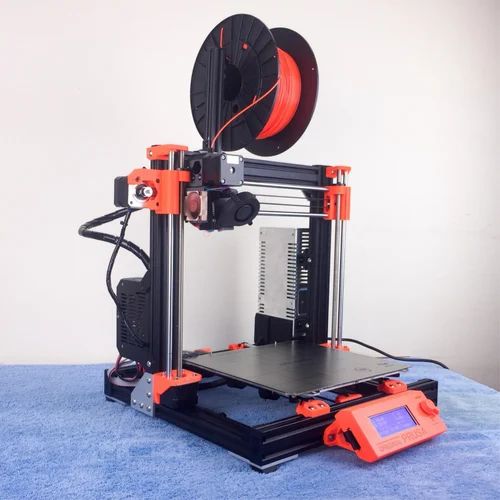 Filament is loaded and stored in many different ways on FFF 3D printers. This can range from basic printers, where the spool must sit separately, to professional solutions that offer front-loading and automatically switch spools when a filament finishes
Filament is loaded and stored in many different ways on FFF 3D printers. This can range from basic printers, where the spool must sit separately, to professional solutions that offer front-loading and automatically switch spools when a filament finishes
You can compare the features of Ultimaker 3D printers here.
Finally, it’s important to mention software. Unless you have all the 3D prints you will ever need sitting on a USB stick, you will not be able to do much without the right software.
In 3D printing, software plays two important roles. First, a “slicing” program like Ultimaker Cura is essential for preparing a design file (such as an STL) for print. Load the file into this software, choose your desired print settings (such as fast or extra detail), and it will “slice” it into layers then create a file format the printer understands.
Preparing a model to be 3D printed using Ultimaker Cura software
This print job can then be transferred to the printer manually (such as on a USB stick) or sent remotely over the network or cloud. This is where software can play the role of sending, queuing, and tracking these print jobs. Cloud software such as the Ultimaker Digital Factory is enabling the next generation of FFF technology, delivering distributed manufacturing across multiple locations.
This is where software can play the role of sending, queuing, and tracking these print jobs. Cloud software such as the Ultimaker Digital Factory is enabling the next generation of FFF technology, delivering distributed manufacturing across multiple locations.
Watch this video to see how one manufacturer has created a "digital warehouse" by combining FFF 3D printers and software.
Watch the videoWant to learn more about how the 3D printing workflow could look for you?
Read our ‘How to design for FFF 3D printing’ white paper for valuable tips for getting started with an FFF printer, more detail about the role of support materials, and design for FFF insights from 3D printing experts.
Learn the modeling tips and tricks that we use to maximize our print success, including:
• How to 3D print faster
• Easy ways to use less support material
• Best practices for finer print details
• And lots more!
Introduction to Fused Filament Fabrication (FFF) 3D printing technology
This White Paper will get you familiar with the process of Fused Filament Fabrication (FFF) for plastics, in which layers of material are built up to create a solid object.

Download the full White Paper here>
What does FFF mean in 3D printing?
Fused Filament Fabrication (FFF) is an extrusion process where the object is built by depositing melted material layer-by-layer. The plastics used correspond to the same thermoplastics that can be found in conventional manufacturing processes, like ABS and Nylon.
FFF led the expansion of desktop 3D printers and is now the most widespread 3D Printing Technology, essentially due to the low initial investment needed, the immense variety of applications offered, and the little specific knowledge required to successfully use this technology.
How does FFF work?
As mentioned above, FFF consists of an extrusion process of melted plastic. In order to generate the part, a print head travels around the printing surface depositing the material.
The workflow is as follows:
- The first stage consists of generating the 3D model with any design software, such as Solidworks or Catia.
 The 3D model needs to be exported in STL format.
The 3D model needs to be exported in STL format. - In file preparation, the model is configured using a slicing software including all the printing requirements. This configuration will contain the material selection and the nozzle size. The software also separates the model into layers, and you can configure the printing quality, and movement commands.
- The printing phase is the deposition of the melted plastic.
In-house desktop 3D printers: FFF vs SLA
The most popular 3D printing technologies are FFF and SLA. SLA is a liquid photopolymer selectively cured by UV light.
Both technologies have their own benefits and disadvantages depending on your business’ needs.
Professional desktop 3D printers compared to industrial printers and outsourcing
Within the FFF technology market, there are different printer categories based on the relation between price and printing quality.
Should the number of parts to produce be low and the usage planned to be sporadic, there is the option to outsource the 3D printing service through a 3D printing service bureau.
If the plan is to work on a medium-long term project, the acquisition of 3D printers can reduce costs significantly. This acquisition implies an initial investment, but then the price per part becomes approximately 30 times cheaper.
Which solution best fits your needs
It is important to take into consideration parameters such as cost and lead time:
In-house FFF printers offer the best combination of costs and lead times. However, investing in both FFF and SLA printing technologies will give your company full versatility when producing parts. To weigh the benefits for your company, read our white paper and have a think about your answers to these questions:
- What is my budget?
- Does my company have specialized equipment to support a 3D printer?
- Do I need to print mechanically demanding parts?
- Will there be designing and application versatility?
- How many printed parts does my company require?
- What is the lead time my company requires?
Would you like to know more about 3D printing? Check out the following white papers:
• Introduction to FFF technology and its most important parameters
• Anatomy of Sigma & Sigmax R19 extrusion system
Ready to save time and cut costs with a BCN3D printer? Request a customized quotation for a BCN3D Printer.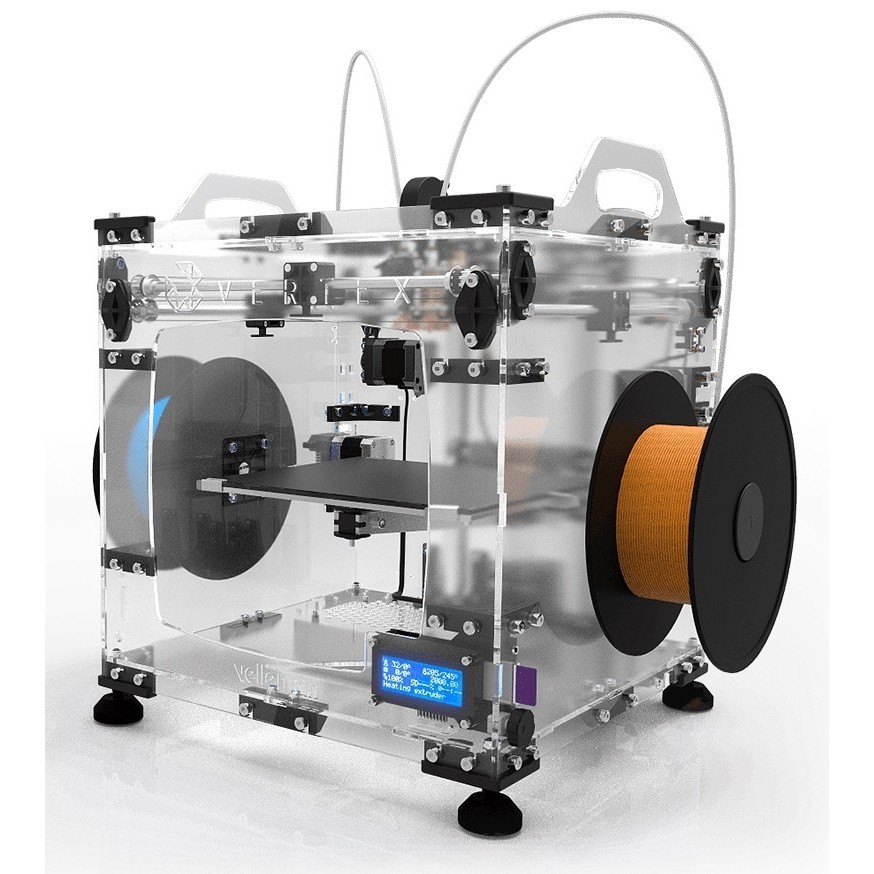
Fused Filament Fabrication - HiSoUR Cultural History
Fused filament fabrication (FFF) is a 3D printing process that uses a continuous filament of thermoplastic material. This is fed from a large spool through the moving heated head of the printer's extruder. The molten material is forced out of the print head nozzle and deposited on the growing workpiece. The head moves under the control of the computer to determine the printing form. Typically the head moves through the layers, moving in two dimensions to place one horizontal plane at a time before moving up a bit to start a new slice. The speed of the extruder head can also be controlled, stop and start deposition, and form a discontinuous plane without slicing or dribbling between sections. Fused filament fabrication was coined by members of the RepRap project to provide a phrase that would be legally unconditional in its use, given patents covering fused deposition modeling (FDM).
Milled filament interaction is now the most popular process (by number of machines) for hobby 3D printing. Other methods, such as photopolymerization and powder sintering, may provide better results, but their costs increase significantly.
Other methods, such as photopolymerization and powder sintering, may provide better results, but their costs increase significantly.
The 3D print head or 3D printer extruder is the part of the extrusion printing machine that is responsible for melting the raw material and turning it into a continuous profile. A wide range of materials are extruded, including thermoplastics such as acrylonitrile butadiene styrene (ABS), polylactic acid (PLA), high impact polystyrene (HIPS), thermoplastic polyurethane (TPU), aliphatic polyamides (nylon) and recently also PEEK. Pasty materials such as ceramics and chocolate can be extruded using a fused filament process and a paste extruder.
Introduction
Additive manufacturing (AM), also called 3D printing, involves the manufacture of a part by depositing a material in a layer. There is a wide range of different AM technologies that can be layer by layer, including material extrusion, jet remelting, material jetting, and directed energy deposition.
These processes have different types of extruders and extrude different materials to reach the final product using incremental material additions. The Liquefier 3D printer is a component that is mainly used in material extrusion printing machine.
extrusion
3D printing extrusion using material extrusion includes a cold end and a hot end.
The cold end is part of the extruder system that pulls and feeds material from the spool and pushes it towards the hot end. The cold end is mainly the torque on the roller or material roller and the control of the feed rate by the stepper motor. Thus, the speed of the process is controlled.
The hot end is the active part, which also houses the 3D printer fluidizer that melts the filament. This allows the molten plastic to exit the small nozzle, forming a thin, sticky rim of plastic that will adhere to the material it rests on. the hot end consists of a heating chamber and a nozzle. The hole in the tip (nozzle) has a diameter of 0. 3 mm to 1.0 mm. Depending on the print media, different types of nozzles and heating methods are used.
3 mm to 1.0 mm. Depending on the print media, different types of nozzles and heating methods are used.
Some types of 3D printing presses may have a different extrusion system that may not have a heating chamber - the heat is supplied from another source such as a laser.
xtruder mount for the rest of the machine
The extruder methods found on the rest of the machine have evolved over time into informal mounting standards. These informal standards include:
Vertical X-Axis Standard
Quick Release Extruder
OpenX mount
etc.
These factorial standards allow testing new extruder designs on existing print frames and new printer frame designs using existing extruders.
Fused Deposition Simulation
Fluid Deposition Modeling (FDM) is an additive technology (AM) commonly used for simulation, prototyping and manufacturing applications as a trademark of Stratasys Inc. This is one of the methods used for 3D printing. FDM is working on an "additive" principle, stacking material in layers; plastic thread or metal wire is unwound from a spool and feeds material to produce a part. Therefore, FDM is also known as solid materials based AM technology.
history
Fused deposition modeling (FDM) was developed by S. Scott Crump in the late 1980s and was commercialized in 1990 by Stratasys. With the expiration of US 5,121,329 A on this technology, there is now a large community of open source developers (called RepRap) as well as commercial and DIY variants, all of which use this type of 3D printer. This led to a price reduction of two orders of magnitude compared to the creation of this technology.
Process
FDM begins with a software process that processes an STL file (STEREOlithography file format), mathematically slicing and orienting the model for the assembly process. Support structures can be created if necessary. The machine can distribute several materials to achieve different purposes:
One material can be used to create a model.
Use other as a soluble support structure.
You can use multiple colors of the same type of thermoplastic on the same model.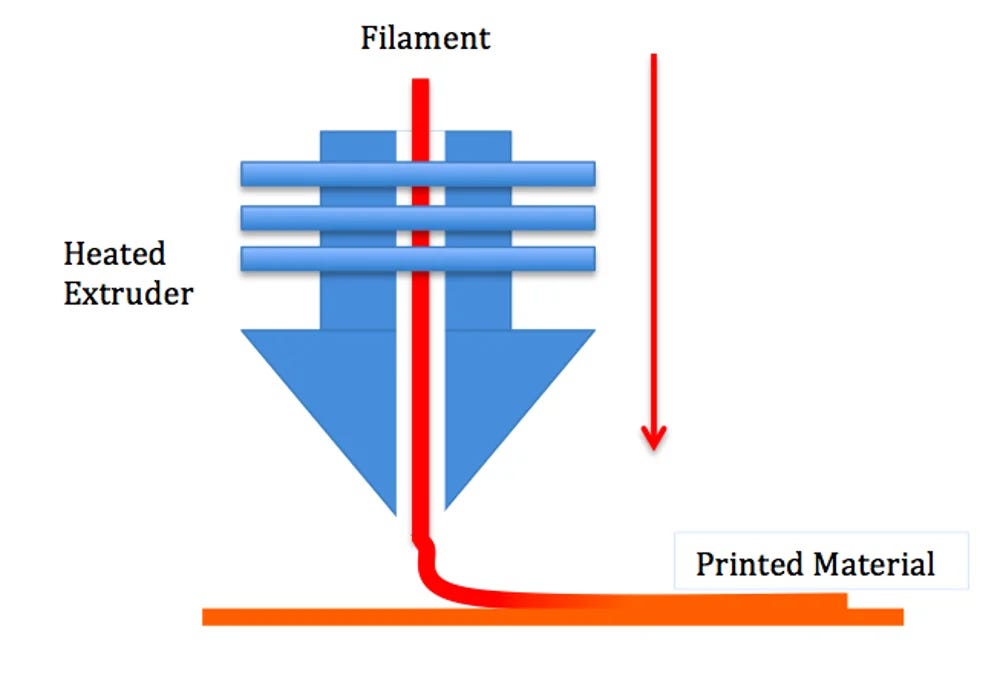
Model or part thereof is made by extruding small flattened strings of molten material in layers as the material solidifies immediately after being extruded from the nozzle.
The filament is unwound from the spool and feeds the material into the extrusion nozzle, which can turn the flow on and off. There is usually a finely controlled drive that pushes the filament into the nozzle.
The nozzle is heated to melt the material. Thermoplastics are well heated beyond the glass transition temperature and then deposited by the extrusion die.
The nozzle can be moved horizontally and vertically by means of a numerical control mechanism. The nozzle follows a tool path controlled by a computer-aided manufacturing (CAM) software package, and the part is built from the bottom up, one layer at a time. Stepper motors or servo motors are commonly used to move the extrusion head. The mechanism used is often a straight line XYZ design, although other mechanical designs such as the deltabot are used.
Although the FDM printing technology is very flexible and able to deal with small protrusions from the support from the underlying layers, FDM usually has some limitations on the slope of the canopy and cannot create unsupported stalactites.
Countless materials are available such as acrylonitrile butadiene styrene (ABS), polylactic acid (PLA), polycarbonate (PC), polyamide (PA), polystyrene (PS), lignin, rubber, among many others, with various compromises between strength and thermal properties. In addition, even the color of a given thermoplastic material can affect the strength of the printed object. Recently, a German company demonstrated for the first time the technical feasibility of processing granular PEEK in the form of a filament and 3D printed parts from the filament material using FDM technology.
During FDM, hot molten polymer is exposed to air. Operating the FDM process in an inert gas atmosphere such as nitrogen or argon can significantly increase layer adhesion and improve the mechanical properties of 3D printed objects. An inert gas is typically used to prevent oxidation during selective laser sintering.
An inert gas is typically used to prevent oxidation during selective laser sintering.
General Process
Part focuses on extruder flow geometry, heating method, and non-Newtonian fluid melt behavior.
The filament is fed from a drum, either commercially available or homemade, and fed into a heated liquefier where it is melted. This melt is then extruded by a nozzle and the incoming filament, still in the solid phase, acts as a "plunger".
The nozzle is mounted on a mechanical stage that can move in the xy plane. As the nozzle moves across the table in a given geometry, it deposits a thin bead of extruded plastic called a "road" that quickly solidifies upon contact with the substrate and/or roads deposited previously.
Solid layers are generated following a rasterizing motion where roads are deposited side by side within the boundary of an enclosing area.
Once the layer is completed, the platform will be lowered in the z direction to start the next layer.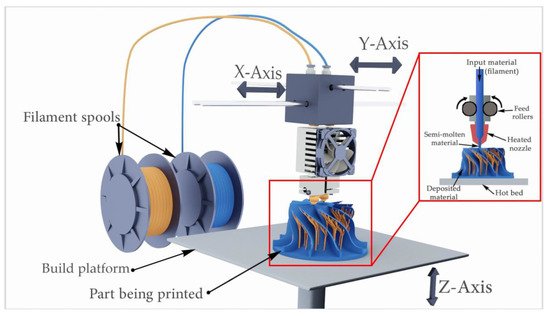 This process continues until the object is completed.
This process continues until the object is completed.
For successful road bonding, the thermal environment must be controlled during the process. Therefore, the system is stored inside a chamber maintained at a temperature just below the melting point of the deposited material.
physics
During extrusion, a thermoplastic thread is introduced by mechanical pressure from rollers into a liquefier, where it is melted and then extruded. The rollers are the only drive mechanism in the material delivery system, so the filament is under tensile stress above the roller and under compression on the downstream side acting as the plunger. Therefore, compressive stress is the driving force behind the extrusion process.
The force required to extrude the melt must be sufficient to overcome the differential pressure in the system, which is strictly dependent on the viscous properties of the melted material and the fluid flow and nozzle geometry. The molten material undergoes shear deformation during flow. Most of the materials used in this type of 3D printing exhibit shear thinning behavior. This is modeled using a power law for generalized Newtonian fluids.
Most of the materials used in this type of 3D printing exhibit shear thinning behavior. This is modeled using a power law for generalized Newtonian fluids.
The temperature is controlled by the input of heat from electric coil heaters. The system continuously adjusts the power delivered to the coils according to the temperature difference between the desired value and the value detected by the thermocouple, forming a negative feedback loop. This is analogous to heat flow in a cylindrical pipe.
Commercial Applications
FDM, a well-known form of rapid prototyping, is used for prototyping and rapid manufacturing. Rapid prototyping facilitates iterative testing, and for very short runs, rapid manufacturing can be a relatively inexpensive alternative.
FDM uses PLA, ABS, ABSi, polyphenylsulfone (PPSF), polycarbonate (PC), PETG and Ultem 9085 thermoplastics and others. These materials are used for their heat resistant properties. Ultem 9085 is also fire retardant making it suitable for aerospace and aviation applications.
FDM is also used in prototyping scaffolds for medical engineering applications.
Free Applications
Several projects and companies are making efforts to develop affordable 3D printers for home desktop use. Much of this work has been driven and targeted at the DIY/enthusiast/early adopter communities, with additional connections to the academic and hacker communities.
RepRap is one of the longest running projects in the desktop category. The RepRap project aims to create a free and open source (FOSH) 3D printer whose full specifications are released under the GNU General Public License and which is capable of replicating itself by printing many of its (plastic) parts to create a larger machine. RepRaps has been shown to be able to print printed circuit boards and metal parts.
Fab@Home is another open source project for DIY 3D printers.
Due to the goals of FOSH RepRap, many related projects have used their designs for inspiration, creating an ecosystem of related or derivative 3D printers, most of which are also open source projects.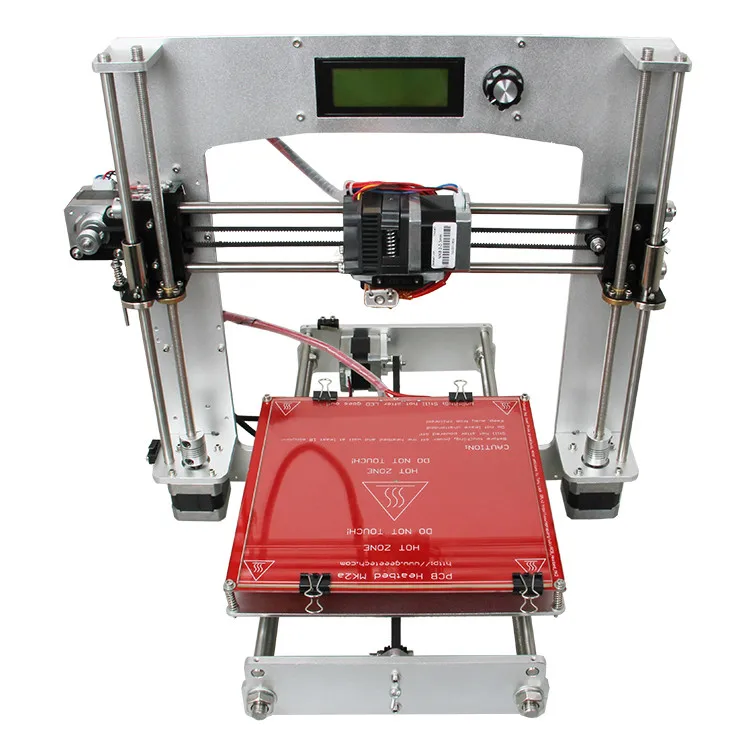 Having these open source designs means that 3D printer options are easy to invent. However, the quality and complexity of printer designs, and the quality of the kit or finished product, vary greatly from project to project. This rapid development of open source 3D printers is gaining interest in many areas as it allows for hyper-standardization and the use of public domain projects to create open source technology. This technology can also help sustainability initiatives because the technology makes it easy and cost effective to use the resources available to local communities.
Having these open source designs means that 3D printer options are easy to invent. However, the quality and complexity of printer designs, and the quality of the kit or finished product, vary greatly from project to project. This rapid development of open source 3D printers is gaining interest in many areas as it allows for hyper-standardization and the use of public domain projects to create open source technology. This technology can also help sustainability initiatives because the technology makes it easy and cost effective to use the resources available to local communities.
Cost of a 3D printer
The cost of 3D printers has dropped significantly since 2010, when $20,000 machines now cost less than $1,000. For example, as of 2017, several companies and individuals are selling parts to build various RepRap designs with prices starting at around £99/$100. The best-selling desktop FDM printer, the Prusa i3 MK2, costs US$900 assembled or US$600 for a DIY kit.
The Fab@Home Open Project has designed printers for general use with anything that can be pressed through a nozzle, from chocolate to silicone sealant and chemicals. Project-following printers have been available to vendors in kits or pre-assembled form since 2012, priced in the $2,000 range.
Project-following printers have been available to vendors in kits or pre-assembled form since 2012, priced in the $2,000 range.
LulzBot 3D printers from Aleph Objects are another example of open source soft deposition technology applications. The flagship model in the LulzBot line, the TAZ printer inspires him to design RepRap Mendel9 models0 and Prusa i3. The LulzBot 3D Printer is currently the only printer of its kind to receive the "Respects Your Freedom" certification from the Free Software Foundation.
As of September 2018, RepRap type printers are readily available as a kit through online retailers such as Amazon and eBay. These kits come complete with all the parts needed to build a functioning printer, often including electronic test print files, as well as a small amount of PLA filament. One of the popular printers of this variety is the Anet A8, which costs $200 and can easily print objects when assembled. The build process takes approximately 6 to 8 hours and is well documented on video filming sites such as YouTube.
development
Customer customization of the product and the demand for saving time and time increase interest in the flexibility of the production process. This has led to improvements in RR technologies and, in particular, to fused deposition modeling. Extruder development is booming due to the open source 3-D movement driven by products like RepRap. Consistent improvements show up in the form of higher fluidizer heating temperatures, overall process control and accuracy, and improved support for a wide range of print materials, including ceramics.
The extruder methods installed on the machine have also evolved over time into informal mounting standards. These unofficial standards include Vertical X Axis Standard, Fast Extruder, OpenX Mount, etc.
Print Head Kinematics
Most condensed filament printers follow the same basic design. A flat bed is used as the starting point for the print blank. The gantry above it carries a moving print head. The gantry design is optimized to move in mostly horizontal X and Y directions, with a slow rise in the Z direction when the piece is printed. Stepper motors drive movement either with screws or timing belts. Due to differences in travel speed, toothed belts are often used for X, Y drives and a lead screw for Z. Some machines also have X-axis movement on the gantry, but move the bed (and print job) for Y Because, unlike laser cutters, head speed is low, stepper motors are versatile and servo motors do not need to be used instead.
Stepper motors drive movement either with screws or timing belts. Due to differences in travel speed, toothed belts are often used for X, Y drives and a lead screw for Z. Some machines also have X-axis movement on the gantry, but move the bed (and print job) for Y Because, unlike laser cutters, head speed is low, stepper motors are versatile and servo motors do not need to be used instead.
Many printers, originally influenced by the RepRap project, make extensive use of 3D printed components in their own design. These are usually printed junction blocks with various angled holes connected by a cheap steel threaded rod. This makes for a design that is cheap and easy to assemble, easily allows for perpendicular articulation but requires access to a 3D printer. The notion of "bootable" 3D printers like this has been something of a dogma in the RepRap projects. Lack of rigidity in the stem also requires either triangulation or creates the danger that the gantry structure will bend and vibrate in service, reducing print quality.
Many machines now use semi-enclosed box frames made of laminated plywood, plastic or pressed steel sheet. They are cheap, rigid, and can also be used as a base for a closed print volume, allowing the temperature within it to be controlled to control print job warping.
Several machines use polar coordinates instead, usually machines are optimized for printing objects with circular symmetry. They have a radial gantry movement and a rotating bed. Despite some potential mechanical advantages of this design for printing hollow cylinders, their different geometries, and thus not a mainstream approach to print planning, still prevent them from being popular. Even though planning a robot's motion is a simple task to convert from Cartesian to polar coordinates, getting any benefit from this design also requires the print slicing algorithms to be aware of rotational symmetry from the start.
Germ printers
A different approach is taken to the Rostock type printers based on the delta robot mechanism. They have a large open print volume with a three arm delta robot mounted on top. This robot design features low inertia and the ability to move quickly over a large volume. However, stability and freedom from vibration while moving the heavy printhead at the end of the spindle arms is a technical challenge. This design was mainly used as a means to get a high volume print without a large and heavy port.
They have a large open print volume with a three arm delta robot mounted on top. This robot design features low inertia and the ability to move quickly over a large volume. However, stability and freedom from vibration while moving the heavy printhead at the end of the spindle arms is a technical challenge. This design was mainly used as a means to get a high volume print without a large and heavy port.
As the print head travels the distance of its filament from the storage spool to the head also changes, the stress created on the filaments is another technical challenge to overcome so as not to affect print quality.
Best 3D Printers of 2020
Our list of the best 3D printers has something for everyone, whether you're an aspiring 3D artist, hobbyist, or business owner looking for an enterprise-quality 3D printer for commercial use..
We not only researched the market to find the best of the best for you, but we also found a variety of printers covering a wide range of sizes, prices and features. This list has something to suit your table, meet the needs of hobbyists, meet the high demands of the business, and even handle high-volume products. You'll also find the best 3D printers for a wide range of budgets, from low-end 3D printers to high-end 3D printers that may have a hefty price tag but offer unbeatable quality.0003
This list has something to suit your table, meet the needs of hobbyists, meet the high demands of the business, and even handle high-volume products. You'll also find the best 3D printers for a wide range of budgets, from low-end 3D printers to high-end 3D printers that may have a hefty price tag but offer unbeatable quality.0003
There are many 3D printers to choose from, and there are several factors to consider when choosing the best 3D printer for you, which means you'll spend quite a bit of time researching. Don't worry though; our list of the best 3D printers should get you started.
Our list of the best 3D printers provides clear and concise information about all kinds of 3D printers, so you can find the best 3D printer for whatever your needs. And we've included our exclusive price comparison tool, so you can be sure you'll find the best deal on your dream 3D printer - don't wait Black Friday and Cyber Monday .
Just keep in mind that because this list is so diverse - and the 3D printers in it are designed for different use cases - we didn't list them in any particular order.
- Original PRUSA i3 MK3s
- CEL-UK RoboxPro
- Ultimaker S3
- FormLabs Form 3
- Original PRUSA SL1
- TRILAB DeltiQ 2
- Ultimaker 2+
- CEL-UK RoboxDual
- LulzBot Mini 2
- XYZPrinting da Vinci Mini+
- Crazy3DPrint CZ-100
- AnyCubic Foton
- Find out which printers made our top 10 business printers
(Image credit: original)
1. Original PRUSA i3 MK3s
Best all-in-one 3D printer
Print technology: Fused deposition simulation | Filament diameter: 1.75 mm | Building area: 250 x 210 x 210 mm | Minimum layer resolution: 50 microns | Maximum layer resolution: 350 microns | Dimensions: 550 x 400 x 500 mm | Weight: 7kg w/o spool
Check WalmartCheck AmazonSee all prices (2 found) High print speedMarket-leading print qualityOpen design
PRUSA Research is a dominant force in the 3D printing community and the MK3 is their flagship machine. Available as a kit, expert build, or as a set of plans to build your own, there's something here for every level of user. The expert build improves on everything that came before and is considered the best FDM 3D printer on the market. Print speeds are fast, and thanks to the latest Trinamic2130 drivers and Noctua fan, this machine runs almost silently. Powerful enhancements such as filament sensors, Bondtech extruder, P.I.N.D.A. 2 probes and the market-leading E3D V6 nozzle deliver unparalleled print quality. The features and print quality make the MK3s the best all-around printer.
Available as a kit, expert build, or as a set of plans to build your own, there's something here for every level of user. The expert build improves on everything that came before and is considered the best FDM 3D printer on the market. Print speeds are fast, and thanks to the latest Trinamic2130 drivers and Noctua fan, this machine runs almost silently. Powerful enhancements such as filament sensors, Bondtech extruder, P.I.N.D.A. 2 probes and the market-leading E3D V6 nozzle deliver unparalleled print quality. The features and print quality make the MK3s the best all-around printer.
Buy from Prusa Research
(Image credit: CEL-UK)
2. CEL-UK RoboxPro
Best for commercial printing
Print technology: Fused deposition simulation | Filament diameter: 1.75 mm | Building area: 210 x 300 x 400 mm | Minimum layer resolution: 50 microns | Maximum layer resolution: 500 µm | Dimensions: 513x508x605 mm | Weight: 26kg
Check WalmartCheck AmazonSee all prices (2 found) Replaceable PrintheadsNetwork ReadyLarge Scale Printer
CEL-UK is a leader in 3D printing innovation with original Robox printers introducing many new features to the 3D world FDM printers. RoboxPro is Robox on a grand scale with a feature set that reads like a 3D printing wishlist; automatic filament loading, automatic layer alignment, Wi-Fi, network printing and interchangeable tool heads. The focus of the machine is on quality and reliability, designed for those who need a printer capable of bringing product ideas to life and bringing it to market. The closed design makes it ideal for commercial and educational use..
RoboxPro is Robox on a grand scale with a feature set that reads like a 3D printing wishlist; automatic filament loading, automatic layer alignment, Wi-Fi, network printing and interchangeable tool heads. The focus of the machine is on quality and reliability, designed for those who need a printer capable of bringing product ideas to life and bringing it to market. The closed design makes it ideal for commercial and educational use..
(Image credit: Ultimaker)
3. Ultimaker S3
Best for College Education
Print Technology: Fused Deposition Simulation | Filament diameter: 2.85 mm | Building area: 230 x 190 x 200 mm | Minimum layer resolution: 20 microns | Maximum layer resolution: 600 µm | Dimensions: 394 x 489 x 637 mm | Weight: 14.4kg
Check WalmartCheck AmazonSee all prices (2 found) Best-in-class print qualityEasy to networkExpensive
Ultimaker has been one of the hottest 3D printer manufacturers ever since 3D printing became mainstream. Ultimaker S3 is the next generation printer with speed, quality and reliability. While the machine makes a small mark of preference for open source Ultimakers, this one, and the rest of the new S line, break new ground when it comes to usability and business integration. S3 is aimed at educational and commercial markets and offers a wide range of accessories and materials to meet any designer's needs. Highlights include replaceable cartridges, a market-leading touch screen interface, and Cura cutting software..
Ultimaker S3 is the next generation printer with speed, quality and reliability. While the machine makes a small mark of preference for open source Ultimakers, this one, and the rest of the new S line, break new ground when it comes to usability and business integration. S3 is aimed at educational and commercial markets and offers a wide range of accessories and materials to meet any designer's needs. Highlights include replaceable cartridges, a market-leading touch screen interface, and Cura cutting software..
(Image credit: FormLabs)
4. FormLabs Form 3
Best SLA Printer
Print Technology: Stereolithography | Resin type: Multiple | Building area: 145 × 145 × 185 mm | Minimum layer resolution: 25 microns | Maximum layer resolution: 300 µm | Dimensions: 405 x 375 x 530 mm | Weight: 17.5KG
Check WalmartCheck AmazonSee all prices (2 found) High quality printingWide material supportSL prints require cleaning
FormLabs specializes in resin SLA 3D printers and plays an important role in the development and development of this technology. The Form 3 is the smallest of their machines but has a wide appeal due to the use of a high precision laser that delivers unparalleled print quality, far superior to FDM printers. As with all SLA printers, liquid resin is used rather than solid filament, so it takes more time to prepare and process prints, which is not suitable for all users. However, the breadth of materials and technology makes the Form 3 one of the most versatile 3D printers on the market. Ideal for high quality prototypes, jewelry, casting and manufacturing.
The Form 3 is the smallest of their machines but has a wide appeal due to the use of a high precision laser that delivers unparalleled print quality, far superior to FDM printers. As with all SLA printers, liquid resin is used rather than solid filament, so it takes more time to prepare and process prints, which is not suitable for all users. However, the breadth of materials and technology makes the Form 3 one of the most versatile 3D printers on the market. Ideal for high quality prototypes, jewelry, casting and manufacturing.
(Image credit: original)
5. Original PRUSA SL1
Best MSLA printer
Print technology: Stereolithography | Resin type: 405nm | Building area: 120 x 68 x 150 mm | Minimum layer resolution: 25 microns | Maximum layer resolution: 100 µm | Dimensions: 400 × 237 × 225 mm
Check WalmartCheck AmazonSee all prices (2 found) High quality printingWide material supportSL prints require cleaning
Prusa Research has revolutionized the FDM 3D printer market and the SL1 looks set to do the same for SLA printers.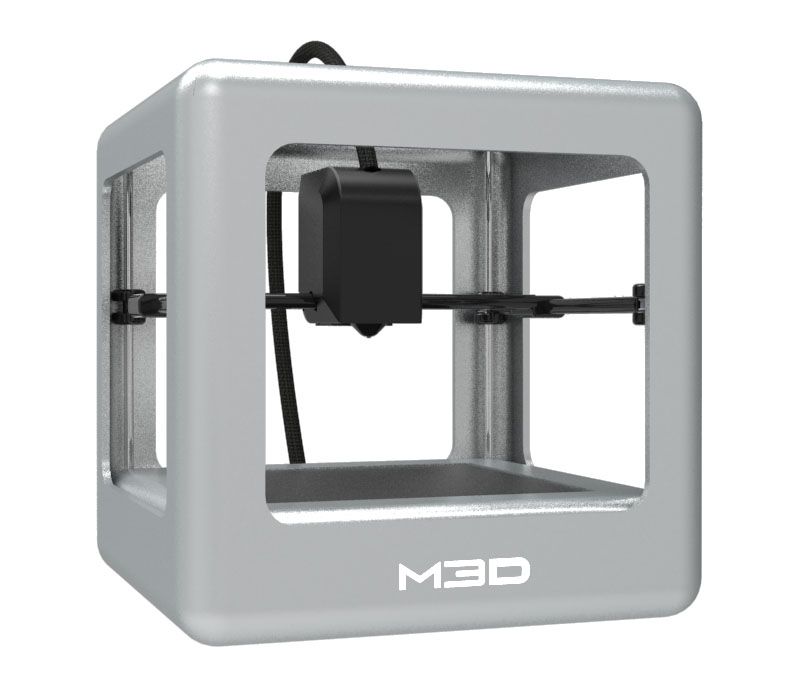 Although the printer uses stereolithography technology, it is a small variant known as MSLA. It uses an LCD and a UV LED for resin exposure and is much cheaper than high precision lasers like Form 3. While the components may be cheaper, the results are backed by PrusaSlicer's excellent software and tremendous openness. Coming from the community, SL1 looks set to be a game changer in the SLA market.
Although the printer uses stereolithography technology, it is a small variant known as MSLA. It uses an LCD and a UV LED for resin exposure and is much cheaper than high precision lasers like Form 3. While the components may be cheaper, the results are backed by PrusaSlicer's excellent software and tremendous openness. Coming from the community, SL1 looks set to be a game changer in the SLA market.
(Image credit: TRILAB)
6. TRILAB DeltiQ 2
Best Delta 3D Printer
Print Technology: Fused Deposition Simulation | Filament diameter: 1.75 | Building area: 250 x 250 x 300 mm | Minimum layer resolution: 50 microns | Maximum layer resolution: Depends on nozzle | Dimensions: 410 × 500 × 810 mm | Weight: 10kg
Check WalmartCheck AmazonSee all prices (2 found) Latest TechnologyVersatile and ExpandableIntegrated Machine
Delta 3D printers are very different from standard Cartesian 3D printers as the printhead is suspended on three articulated arms. The approach means that the footprint of machines can be much smaller, and as a static basis, complex models can be a printer with less support material. The DeltiQ 2 features read like a wishlist of 3D features and components. These include E3D hotend, Duet 2 Wifi control board, mobile control and interface, and of course excellent print quality.
The approach means that the footprint of machines can be much smaller, and as a static basis, complex models can be a printer with less support material. The DeltiQ 2 features read like a wishlist of 3D features and components. These include E3D hotend, Duet 2 Wifi control board, mobile control and interface, and of course excellent print quality.
Ultimaker 2+
7. Ultimaker 2+
Best Professional 3D Printer
Print Technology: Fused Deposition Simulation | Minimum layer resolution: 20 microns | Maximum layer resolution: 600 µm | Dimensions: 342 x 493 x 588 mm | 11.3kg design
The Ultimaker 2+ is a 3D printer that offers superior print quality making it one of the best 3D printers for professional use. It's incredibly reliable when it comes to producing 3D models, and the accuracy of the 3D copies is incredibly impressive. If you want a 3D printer that can accurately reproduce many 3D objects, this is a fantastic choice.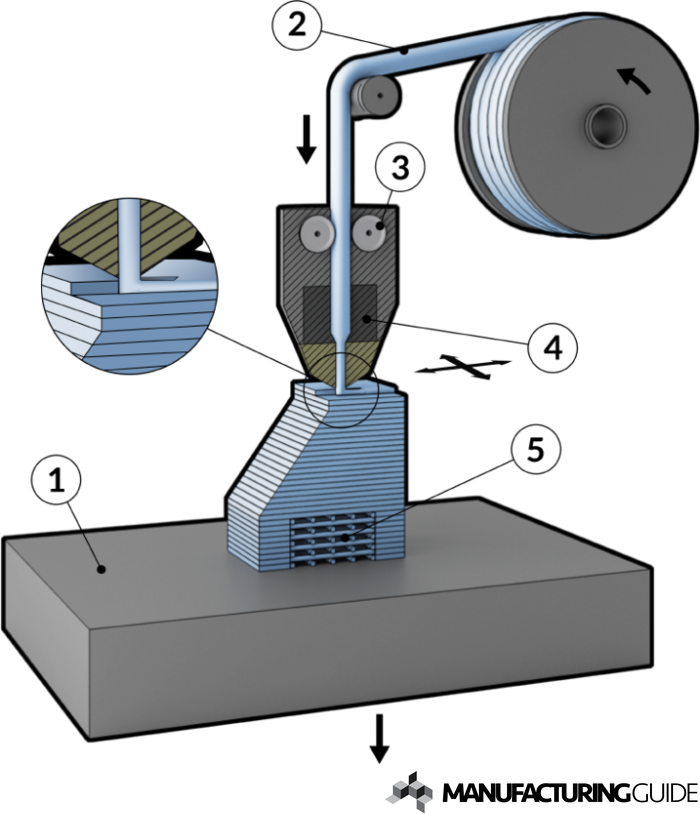 It's expensive, though, and the fact that it's aimed at a professional environment means it's less beginner-friendly than some of the other 3D printers around here. Home users are better off looking elsewhere.
It's expensive, though, and the fact that it's aimed at a professional environment means it's less beginner-friendly than some of the other 3D printers around here. Home users are better off looking elsewhere.
- Here's our pick of the best traditional 2D printers
(Image credit: CEL-UK)
8. CEL-UK RoboxDual
Best for Schools & Businesses
Print Technology: Fused Modeling Deposits 1015 x 210 mm Built-up Area: 9017 | Minimum layer resolution: 50 microns | Maximum layer resolution: 500 µm | Dimensions: 410 x 340 x 240 mm
Check WalmartCheck AmazonSee all prices (2 found) Very easy to use Reliable Advanced features require proprietary filament
Few manufacturers have paid as much attention to 3D printing as CEL-UK. From AutoMaker software that allows you to prepare and control printouts on printers, to special features and accessories that help with iterative design and production. RoboxDual has been designed to adapt to any level of user. SmartReel, interchangeable Headlocks, automatic thread loading, bed leveling make it ideal for use in schools. While with the addition of networking, the inclusion of Root or Mote is perfect for design agencies and engineers working at scale.
RoboxDual has been designed to adapt to any level of user. SmartReel, interchangeable Headlocks, automatic thread loading, bed leveling make it ideal for use in schools. While with the addition of networking, the inclusion of Root or Mote is perfect for design agencies and engineers working at scale.
(Image credit: LulzBot)
9. LulzBot Mini 2
Another great 3D printer for beginners
Print technology: Fused deposition modeling | Building area: 160 x 160 x 180 mm | Minimum layer resolution: 50 microns | Maximum layer resolution: 400 µm | Dimensions: 457 mm x 339 mm x 607 mm | Weight: 9kg
$1750 View at Amazon $2,041.88 View at WalmartSee all prices (4 found) 13 Amazon customer reviews ☆☆☆☆☆ Very easy to use Open source Open frame design
If you're looking for your first 3D printer to study ropes, then the LulzBot Mini 2 is another great choice. It's decently priced and easy to use, and version 2 improves print speed and reduces noise. It's open source hardware, which means it has the flexibility that conciliatory hardware lacks, as a dedicated community of manufacturers can work together to build printer add-ons.
It's decently priced and easy to use, and version 2 improves print speed and reduces noise. It's open source hardware, which means it has the flexibility that conciliatory hardware lacks, as a dedicated community of manufacturers can work together to build printer add-ons.
(Image credit: XYZprinting)0003
10. XYZ Da Vinci Printing Mini+
Best Budget Family 3D Printer
Print Technology: Fused Filament | Building area: 150 x 150 x 150 mm | Minimum layer resolution: 100 µm | Maximum layer resolution: 400 µm | Dimensions: 390 x 335 x 360 mm | Weight: 6.85kg
$129.95View at Amazon $159.95View at Walmart $169.95View at Best BuySee all prices (6 found) Low priceEasy to useDesign can make printed objects difficult to remove
If you're looking for a budget 3D printer, there really is no better option than the XYZprinting da Vinci Mini+. It remains one of the most accessible ways to access 3D printing, and also the easiest, thanks to its easy-to-use interface. Just because it's a budget model doesn't mean it doesn't produce good results, and the 3D print objects it creates are impressive given the price and size of this 3D printer. Speaking of size, the XYZprinting da Vinci Mini is an impressively compact printer that makes it easy to store in the office or on your desk..
It remains one of the most accessible ways to access 3D printing, and also the easiest, thanks to its easy-to-use interface. Just because it's a budget model doesn't mean it doesn't produce good results, and the 3D print objects it creates are impressive given the price and size of this 3D printer. Speaking of size, the XYZprinting da Vinci Mini is an impressively compact printer that makes it easy to store in the office or on your desk..
(Image credit: Crazy3DPrint)
11. Crazy3DPrint CZ-100
Best Budget 3D Printer
Print Technology: Fused Filament | Building area: 300 x 300 x 300 mm | Minimum layer resolution: 100 µm | Maximum layer resolution: 400 µm | Dimensions: 534 x 503 x 582 mm | Weight: 16.5kg
Check WalmartCheck AmazonSee all prices (2 found) Low priceEasy to useLarge print platform
If you want to learn about 3D printing on a budget, then the CZ-300 is the perfect starting point. The open design lets you see all of the printer's work, and Crazy3DPrint ensures that while it's a budget printer, money has been spent where it counts. Despite being a budget offering, this printer boasts one of the largest print platforms of any printer on the market with a whopping 300 x 300 x 300mm. The initial setup is simple initially, but you'll need to keep a close eye on manually leveling the bed, if you get it right, the CZ-300 will reward you with amazingly high quality prints.
The open design lets you see all of the printer's work, and Crazy3DPrint ensures that while it's a budget printer, money has been spent where it counts. Despite being a budget offering, this printer boasts one of the largest print platforms of any printer on the market with a whopping 300 x 300 x 300mm. The initial setup is simple initially, but you'll need to keep a close eye on manually leveling the bed, if you get it right, the CZ-300 will reward you with amazingly high quality prints.
(Image credit: AnyCubic)
12. AnyCubic Photon
Best Budget Printer MSLA
Print Technology: Stereolithography | Resin type: 405nm | Building area: 115 x 65 x 155 mm | Minimum layer resolution: 25 microns | Maximum layer resolution: 100 µm | Dimensions: 220 x 200 x 400 mm
$399.99 View at Banggood.com Check Walmart Check Amazon0003
MSLA printers go fast and fast, but none of them have reached as low a price as the AnyCubic Photon.


